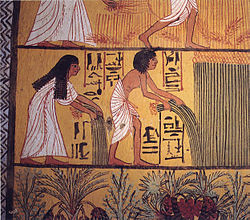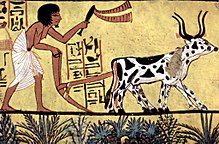Sechet-iaru
| Sechet-iaru in hieroglyphics | ||||||||
|---|---|---|---|---|---|---|---|---|
| New kingdom |
Sechet-iaru Sḫt-j3rw fields of rushes |
|||||||
| 21st dynasty |
|
|||||||
| Late period |
Sechet-iaru Sḫt-j3rw fields of the Iaret |
|||||||
| Harvest in Sechet-iaru (Tomb of Sennedjem ) | ||||||||
Sechet-iaru (also fields of rushes ; short form: Aaru, Earu, Hetep, Iaru, Jaru, Tjau ) is in Egyptian mythology a part of the land Ta-djeser in the Duat , the afterlife ruled by Osiris . In contrast to the darkness of the realm of the dead , it marks the brightly lit region. The area of Sechet-iaru is in turn subdivided into the sub-areas Sechet-hetep and Sechet-tjau , with Sechet-tjau only emerging in the late period from a reading of Sechet-iaru.
background
From the Old Kingdom to the Ptolemaic times , ideas about life in the realm of the dead underwent major changes. Old traditions lived on alongside the respective innovations. The ancient Egyptian Book of the Dead describes the concept of life after death in the Duat in mythological stories. Before the creation of the Book of the Dead, various concepts of the afterlife found literary input in the predecessors of the pyramids and coffin texts .
The term “rush field”, which is mostly insufficiently used for Sechet-iaru, refers to the areas of the Nile Delta and the Fayum oasis , which probably served as models for the descriptions of the afterlife . Due to the stark contrast between the neighboring deserts as a symbol of death and the narrow, fertile strip of green that ran through Egypt, the Egyptians with Sechet-iaru created their ideas of the afterlife while eliminating the dangers.
Meaning of the term
The term Sechet-iaru consists of two separate word meanings. Translations of realms of the blessed lead to misconceptions, since living conditions like in paradise are associated with them. After death, the sixet-iaru not only had the sole purpose of enabling the dead to live in paradise , but also included other mythical aspects.
From the 21st dynasty onwards, the frequent additional use of the snake determinative , which was missing in the mythological papyri of the New Kingdom , is remarkable . In the further course of the late period , the serpent hieroglyph I 14 regularly belonged to the part of Sechet-iaru, whereby the plant and city determinatives appear alternatively in non-mythological papyri.
Sixth
The term "Sechet" stands for field or field , which includes a large region and can therefore also be translated as landscape . An interpretation in the sense of land in terms of field or arable land is therefore not appropriate, since such an area would be suggested . The term "Sechet" referred to several scenic areas:
- Nile flood : Agricultural fields directly on the Nile that were flooded by the annual Nile flood.
- Nile islands : the Nile Valley above the water table lying land that can be farmed as enclosed areas.
- Reed areas : Sections of land with reed zones that occur in stagnant and slowly flowing waters up to a depth of one meter.
- Desert fringes : ponds , oases and arable land that can only be used temporarily , which slowly dries up again after the end of the rainy season .
Iaru
"Iaru" means rush or marsh grass . A secure translation is not available, which is why other meanings may also exist here; for example as a general term for natural vegetation , which is mostly surrounded by watercourses. A reference to plants is considered to be certain, since the word "Iar" in medical papyri refers to a plant or part of a plant .
In addition, there is the determinative of the hieroglyph M 2. Iaru is always written in the plural and can therefore refer to numerous plants or plant fields . There were two species of rush in Egypt that grew widespread in moist soils.
location
Sechet-iaru has been equated to an Elysium and described as a group of wheat-covered islands within rivers. A previously unpublished text indicates that there was an area of watercourses and gardens near Memphis that was called Sechet-iaru and was compared to the Sechet-iaru of the Duat . The sun god visited Sechet-iaru at the ninth hour of the day, which is why the region was initially assumed to be in the southwestern starry sky . The Egyptologist Rolf Krauss was able to localize Sechet-iaru in the southern and southeastern sky region based on the Book of the Dead texts. Sechet-iaru thus represented the forecourt of the divine order of the starry sky as the setting and rising area of the sun .
An irrigation canal is often mentioned in this context, which provided the heavenly fields and was considered to be the equation of the Nile . In the last hours of the night the sun god purified himself in the water of Sechet-iaru, only to be reborn a short time later by Nut and to rise anew every day to begin his day's journey on earth.
In the Book of the Dead 149 the topography is described, according to which there are various hills in the rush landscapes in Sechet-iaru , which are overgrown with grain. The rush landscapes were each surrounded by an ore wall and lay as islands in the middle of the winding Merencha watercourse , which could only be reached by ship. In the area of Sechet-iaru also lived hippos , which can be seen in the context of grain and plants and represented a common habitat. In other representations, management scenes and barge stations can be seen, to which Re-Harachte regularly drove his sky barge .
Activities in Sechet-iaru
Already in earthly time the Egyptians were promised this area on the condition that the tests of the heart would be passed in the later judgment of the dead . Souls weighing less than the pen of Maat ( truth ) were sent to Sechet-iaru. Especially in the Pyramid Texts, the Sechet-iaru are the place of ritual cleansing of the dead. In the coffin texts of the Middle Kingdom, the notion that they ensure the supply of the dead comes to the fore. This idea is also found in the New Kingdom.
After arriving in Ta-djeser, the deceased took over a prepared agricultural field for cultivation. The servants of Horus , who were responsible for the harvest, provided the deceased with all the necessary materials and the lack of food. In order to be freed from the rest of the work, many Egyptians had at least one ushabti given to them as a burial gift . Some sayings from the Book of the Dead describe this mythical aspect as a paradise region :
literature
- Hans Bonnet : Earu-Gefilde , in: Lexicon of the Egyptian religious history. Nikol, Hamburg 2000, ISBN 3-937872-08-6 , pp. 161f.
- Elmar Edel : About the inscriptions on the seasonal reliefs of the “World Chamber” from the Niuserre solar sanctuary. In: News from the Academy of Sciences in Göttingen (NAWG) No. 8, Vandenhoeck & Ruprecht, Göttingen 1961, p. 216.
- Adolf Erman : The Egyptian Religion . BookSurge Publishing 2001, ISBN 0-543-89285-9 , p. 121.
- Harold M. Hays: Transformation of Context: The Field of Rushes in Old and Middle Kingdom Mortuary Literature. In: S. Bickel, B. Mathieu, D'un monde à l'autre: textes des pyramides & textes des sarcophages. Institut français d'archéologie orientale, Cairo 2004, ISBN 2-7247-0379-0 , pp. 175-200.
- Rolf Krauss : Astronomical Concepts and Concepts of the Beyond in the Pyramid Texts. Harrassowitz, Wiesbaden 1997, ISBN 3-447-03979-5 .
- Bertha Porter , Rosalind LB Moss : Topographical bibliography of ancient Egyptian hieroglyphic texts, reliefs, and paintings; Vol. 1: The Theban Necropolis; Private tombs. Griffith Institute, Oxfort 1994.
Individual evidence
-
↑

-
↑

- ↑ Jan Assmann : Death and Beyond in Ancient Egypt . Beck, Munich 2003, ISBN 3-406-49707-1 ; P. 317.
- ^ R. Krauss: Astronomical Concepts and Concepts of the Beyond in the Pyramid Texts . Wiesbaden 1997, pp. 275-278.
- ↑ HM Hays in: S. Bickel, B. Mathieu: D'un monde à l'autre, Textes des pyrmides & texts dessarcophages. Cairo 2004, pp. 175-200.

